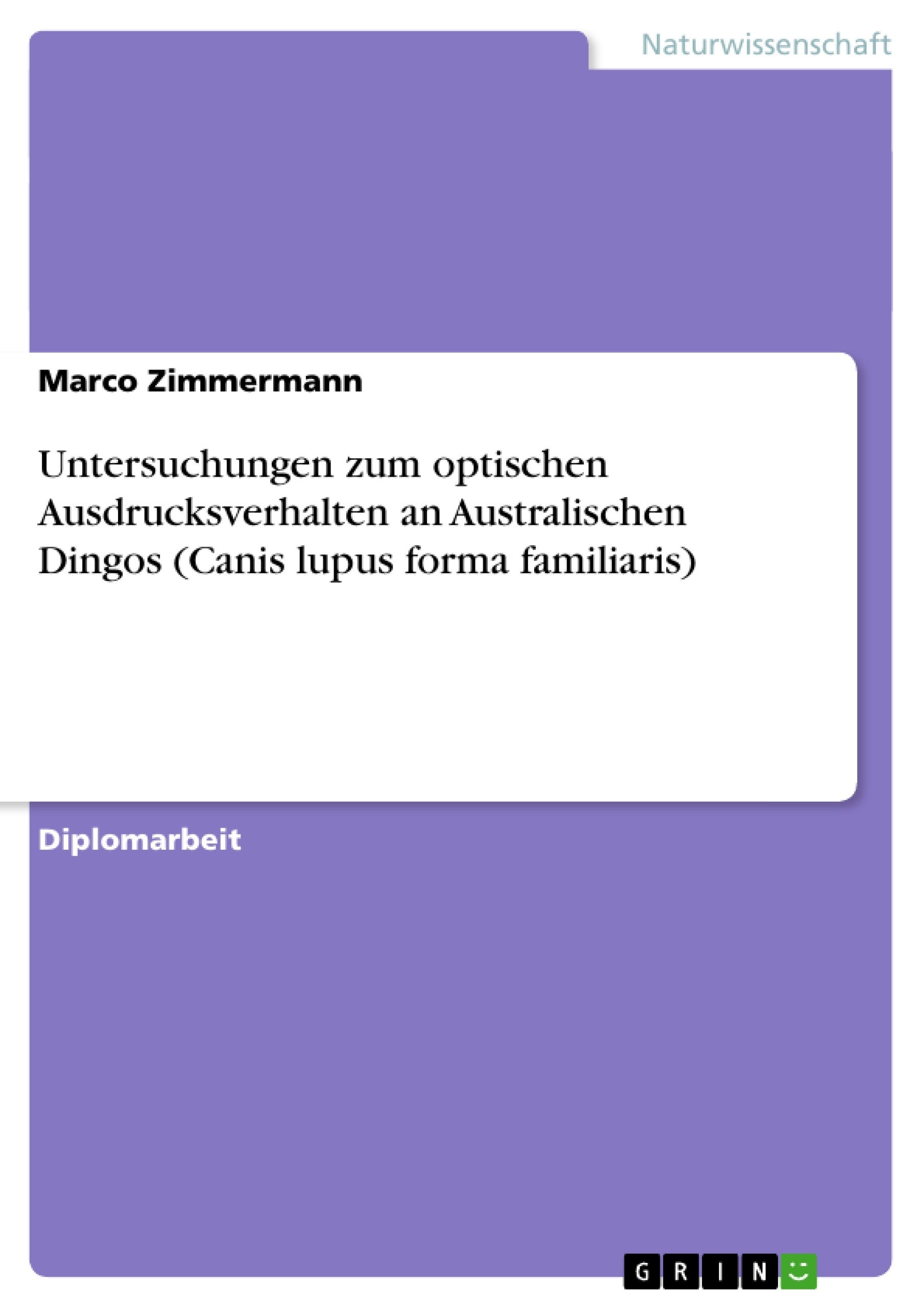Ziel der vorliegenden Arbeit ist es, durch die Erstellung eines Ethogramms (so umfangreich, resp. detailliert wie nötig) einen Einblick in das Sozialverhalten des Australischen Dingos (Canis lupus f. familiaris) zu geben. Da es sich beim Australischen Dingo um einen (verwilderten) Haushund handelt, ist ein Vergleich des Sozialverhaltens mit dem des Wolfes nahe liegend. Die möglicherweise durch Domestikation bedingte Vergröberung mimischer und gestischer Signale, sowie der wölfischen Körperhaltung und -stellung (FEDDERSEN-PETERSEN, 2004) soll hierbei besondere Beachtung finden. Zusätzlich soll das Sozialverhalten des Neuguinea-Dingos vergleichend mit einbezogen werden. (...) So soll in dieser Arbeit eine Analyse der qualitativen Unterschiede in den optischen Ausdrucksstrukturen des Sozialverhaltens zwischen Australischem Dingo, Wolf und dem Neuguinea-Dingo, basierend auf dem 3-Stufen-Modell von HINDE (1976), vorgenommen werden. Zur Vervollständigung der qualitativen Datenerfassung wurden auch Funktionskreise, die nicht unmittelbar kommunikativ wirkende Verhaltensweisen umfassen, aufgeführt.
Inhaltsverzeichnis
- 1. EINLEITUNG
- 2. DOMESTIKATION
- 3. DER DINGO (CANIS LUPUS FORMA FAMILIARIS)
- 4. TIERE, MATERIAL UND METHODEN
- 4.1 Tiere
- 4.2 GEHEGE
- 4.3 DATENAUFNAHME UND -AUSWERTUNG
- 5. ERGEBNISSE
- 5.1 DAS VERHALTENSINVENTAR DER AUSTRALISCHEN DINGOS
- 5.1.1 POSITION UND LOKOMOTION
- A. RUHE UND SCHLAF
- B. ALLGEMEINE BEWEGUNGSFORMEN
- 5.1.2 ORIENTIERUNGSVERHALTEN
- A. NAHORIENTIERUNG
- B. OBJEKTORIENTIERUNG
- C. FERNORIENTIERUNG
- 5.1.3 VERHALTEN DES SCHUTZES UND DER VERTEIDIGUNG
- 5.1.4 STOFFWECHSELBEDINGTES VERHALTEN
- A. NAHRUNGSAUFNAHME
- B. TRANSPORT UND SPEICHERUNG
- C. ERBRECHEN VON FUTTER
- D. DEFÄKIEREN UND URINIEREN
- 5.1.5 KOMFORTVERHALTEN
- 5.1.6 SOZIALES VERHALTEN
- A. ELEMENTE DES OPTISCHES AUSDRUCKSVERHALTEN
- 1. BEIN-, KOPF- UND KÖRPERHALTUNG
- 2. OHRHALTUNG
- 3. AUSDRUCK DER AUGEN UND DER AUGENBRAUEN
- 4. GESICHTSMIMIK
- 5. SCHWANZHALTUNG UND -BEWEGUNG
- A. Schwanzhaltung
- B. Schwanzbewegung
- B. SOZIALES VERHALTEN IN DER GRUPPE
- 1. OPTISCHE VERHALTENSWEISEN BEI NEUTRALER STIMMUNG
- 2. OPTISCHE VERHALTENSWEISEN BEI FREUNDLICHER STIMMUNG
- 3. DEMUTSVERHALTEN
- 4. AGGRESSIVES VERHALTEN
- A. FREIES AGGRESSIVES VERHALTEN
- B. GEHEMMT AGGRESSIVES VERHALTEN
- C. IMPONIERVERHALTEN
- D. DEFENSIVES VERHALTEN
- E. SPIELVERHALTEN
- 1. SPIELBEWEGUNGEN
- 2. INITIALSPIEL
- 3. KONTAKTSPIELE
- A. BEIBSPIELE
- B. RENNSPIELE
- C. SOLITÄRSPIELE
- D. WELPENSPIELE
- F. SEXUALVERHALTEN
- 1. VERHALTEN IN DER HITZE
- 2. VERHALTEN DER WEIBCHEN VOR DER GEBURT
- 5.1.7 INFANTILE VERHALTENSWEISEN
- 5.2 TABELLARISCHER VERGLEICH DER OPTISCHEN AUSDRUCKSSTRUKTUREN DES SOZIALVERHALTENS VON AUSTRALISCHEm Dingo, Neuguinea-DINGO UND WOLF
- 5.3 VERGLEICHENDE DARSTELLUNG DER KATEGORIEN, RESP. FUNKTIONSKREISE DES VERHALTENS BEIM AUSTRALISCHEN DINGO MIT DENEN VOM NEUGUINEA-DINGO UND WOLF: QUALITATIVE ÜBEREINSTIMMUNGEN UND ABWEICHUNGEN
- 5.3.1 VERGLEICHENDE UNTERSUCHUNG ZUM SOZIALVERHALTEN
- A. ELEMENTE DES OPTISCHEN AUSDRUCKSVERHALTENS
- 1. BEIN-, KOPF- UND KÖRPERHALTUNG
- 2. OHRHALTUNG
- 3. AUSDRUCK DER AUGEN UND AUGENBRAUEN
- 4. GESICHTSMIMIK
- 5. SCHWANZHALTUNG UND -BEWEGUNG
- B. SOZIALES VERHALTEN IN DER GRUPPE
- 1. OPTISCHE VERHALTENSWEISEN BEI NEUTRALER STIMMUNG
- 2. OPTISCHE VERHALTENSWEISEN BEI FREUNDLICHER STIMMUNG
- 3. DEMUTSVERHALTEN
- 4. GEHEMMT AGGRESSIVES VERHALTEN
- 5. AGGRESSIVES DROHVERHALTEN
- C. IMPONIERVERHALTEN
- D. DEFENSIVES VERHALTEN
- E. SPIELVERHALTEN
- 1. SPIELBEWEGUNGEN
- 2. INITIALSPIEL
- 3. BEIBSPIELE
- 4. RENNSPIELE
- 5. SOLITÄRSPIELE
- A. ELEMENTE DES OPTISCHEN AUSDRUCKSVERHALTENS
- 5.3.2 ANZAHL DER KATEGORIEN, RESP. FUNKTIONSKREISE DER AUSTRALISCHEN DINGOS, DIE MIT DENEN VON NEUGUINEA-DINGOS UND WÖLFEN IDENTISCH SIND
- 5.3.3 ANZAHL DER KATEGORIEN, RESP. FUNKTIONSKREISE DER AUSTRALISCHEN DINGOS, DIE BEI NEUGUINEA-DINGOS FEHLEN UND Bei Wölfen ideNTISCH SIND
- 5.3.1 VERGLEICHENDE UNTERSUCHUNG ZUM SOZIALVERHALTEN
- 6. DISKUSSION
- 6.1 METHODENDISKUSSION
- 6.2 SOZIALVERHALTEN IM VERGLEICH
- 6.2.1 DISKUSSION DER AUSDRUCKSGESTEN DES SOZIAL-VERHALTENS
- 6.2.2 DISKUSSION DES SOZIALVERHALTENS IN DER GRUPPE
Zielsetzung und Themenschwerpunkte
Diese Diplomarbeit befasst sich mit dem optischen Ausdrucksverhalten von australischen Dingos. Ziel ist es, das Verhaltensspektrum dieser Wildform des Hundes zu analysieren und mit dem Verhalten von Neuguinea-Dingos und Wölfen zu vergleichen. Dabei soll untersucht werden, welche Gemeinsamkeiten und Unterschiede im optischen Ausdrucksverhalten der verschiedenen Caniden bestehen.
- Domestikation und ihre Auswirkungen auf das Verhalten von Caniden
- Untersuchung des optischen Ausdrucksverhaltens von australischen Dingos
- Vergleich mit dem Verhalten von Neuguinea-Dingos und Wölfen
- Analyse von Gemeinsamkeiten und Unterschieden im optischen Ausdrucksverhalten
- Diskussion der Bedeutung der Ergebnisse für das Verständnis der Evolution des Caniden-Verhaltens
Zusammenfassung der Kapitel
- Kapitel 1: Einleitung: Hier wird die Bedeutung der Untersuchung des optischen Ausdrucksverhaltens von australischen Dingos erläutert. Die Arbeit stellt den wissenschaftlichen Kontext der Studie vor und legt die Forschungsfragen fest.
- Kapitel 2: Domestikation: Dieses Kapitel beleuchtet den Prozess der Domestikation und seine Auswirkungen auf das Verhalten von Caniden. Es wird untersucht, wie die Domestikation die Ausdrucksformen von Tieren beeinflusst.
- Kapitel 3: Der Dingo (Canis lupus forma familiaris): Dieses Kapitel bietet eine umfassende Darstellung des Dingo. Es werden die taxonomische Einordnung, Verbreitung, Lebensweise und das Verhalten der Art beschrieben.
- Kapitel 4: Tiere, Material und Methoden: Dieses Kapitel beschreibt die Tiere, die in der Studie verwendet wurden, sowie die Materialien und Methoden der Datenerhebung und -auswertung. Es werden die Studiendesigns, Beobachtungstechniken und statistischen Verfahren vorgestellt.
- Kapitel 5: Ergebnisse: Dieses Kapitel präsentiert die Ergebnisse der Studie. Es werden die Verhaltensweisen der australischen Dingos in verschiedenen Kontexten analysiert und mit dem Verhalten von Neuguinea-Dingos und Wölfen verglichen.
Schlüsselwörter
Australischer Dingo, Canis lupus forma familiaris, optisches Ausdrucksverhalten, Sozialverhalten, Vergleichendes Verhalten, Domestikation, Neuguinea-Dingo, Wolf
- A. ELEMENTE DES OPTISCHES AUSDRUCKSVERHALTEN
- 5.1.1 POSITION UND LOKOMOTION
- 5.1 DAS VERHALTENSINVENTAR DER AUSTRALISCHEN DINGOS
- Quote paper
- Marco Zimmermann (Author), 2007, Untersuchungen zum optischen Ausdrucksverhalten an Australischen Dingos (Canis lupus forma familiaris), Munich, GRIN Verlag, https://www.grin.com/document/93311




